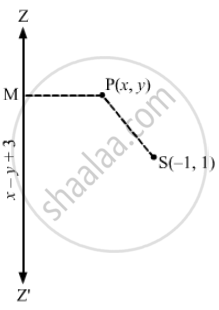Advertisements
Advertisements
Question
Find the equation of the ellipse in the following case:
Length of minor axis 16 foci (0, ± 6)
Solution
\[\text{ Length of minor axis }=16 \text{ and foci }=\left( 0, \pm 6 \right)\]
\[\text{ i . e } . 2b = 16\]
\[ \Rightarrow b = 8\]
\[\text{ and } \]
\[\text{ be } = 6\]
\[ \Rightarrow e = \frac{6}{8}\]
We know that eccentricity e = `sqrt(("b"^2-"a"^2)/"b"^2)`
⇒ 6 = b`sqrt(("b"^2-64)/"b"^2)`
⇒ 36 = b2 - 64
⇒ b2 = 100
The equation of the ellipse is
⇒ `"x"^2/64+"y"^2/100 = 1`
APPEARS IN
RELATED QUESTIONS
Find the equation for the ellipse that satisfies the given conditions:
Vertices (0, ±13), foci (0, ±5)
Find the equation for the ellipse that satisfies the given conditions:
Vertices (±6, 0), foci (±4, 0)
Find the equation for the ellipse that satisfies the given conditions:
Ends of major axis (±3, 0), ends of minor axis (0, ±2)
Find the equation for the ellipse that satisfies the given conditions:
Ends of major axis (0, `+- sqrt5`), ends of minor axis (±1, 0)
Find the equation for the ellipse that satisfies the given conditions:
Length of major axis 26, foci (±5, 0)
Find the equation for the ellipse that satisfies the given conditions:
Foci (±3, 0), a = 4
Find the equation for the ellipse that satisfies the given conditions:
b = 3, c = 4, centre at the origin; foci on the x axis.
Find the equation for the ellipse that satisfies the given conditions:
Centre at (0, 0), major axis on the y-axis and passes through the points (3, 2) and (1, 6)
Find the equation of the ellipse in the case:
focus is (0, 1), directrix is x + y = 0 and e = \[\frac{1}{2}\] .
Find the equation of the ellipse in the case:
focus is (−1, 1), directrix is x − y + 3 = 0 and e = \[\frac{1}{2}\]
Find the equation of the ellipse in the case:
focus is (1, 2), directrix is 3x + 4y − 5 = 0 and e = \[\frac{1}{2}\]

Find the equation to the ellipse (referred to its axes as the axes of x and y respectively) which passes through the point (−3, 1) and has eccentricity \[\sqrt{\frac{2}{5}}\]
Find the equation of the ellipse in the case:
eccentricity e = \[\frac{2}{3}\] and length of latus rectum = 5
Find the equation of the ellipse in the case:
eccentricity e = \[\frac{1}{2}\] and semi-major axis = 4
Find the equation of the ellipse in the case:
eccentricity e = \[\frac{1}{2}\] and major axis = 12
Find the equation of the ellipse in the case:
The ellipse passes through (1, 4) and (−6, 1).
Find the equation of the ellipse in the case:
Vertices (± 5, 0), foci (± 4, 0)
Find the equation of the ellipse in the case:
Vertices (0, ± 13), foci (0, ± 5)
Find the equation of the ellipse in the following case:
Vertices (± 6, 0), foci (± 4, 0)
Find the equation of the ellipse in the following case:
Ends of major axis (± 3, 0), ends of minor axis (0, ± 2)
Find the equation of the ellipse in the following case:
Length of major axis 26, foci (± 5, 0)
A bar of given length moves with its extremities on two fixed straight lines at right angles. Any point of the bar describes an ellipse.
Find the equation of ellipse whose eccentricity is `2/3`, latus rectum is 5 and the centre is (0, 0).
The line 2x + 3y = 12 touches the ellipse `x^2/9 + y^2/4` = 2 at the point (3, 2).
An ellipse is described by using an endless string which is passed over two pins. If the axes are 6 cm and 4 cm, the length of the string and distance between the pins are ______.
The equation of the ellipse having foci (0, 1), (0, –1) and minor axis of length 1 is ______.
